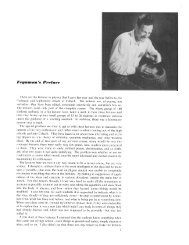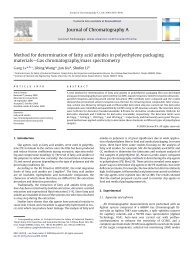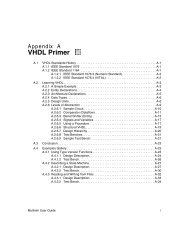Characteristic Aroma Components of British Farmhouse Cheddar ...
Characteristic Aroma Components of British Farmhouse Cheddar ...
Characteristic Aroma Components of British Farmhouse Cheddar ...
Create successful ePaper yourself
Turn your PDF publications into a flip-book with our unique Google optimized e-Paper software.
1382 J. Agric. Food Chem. 2001, 49, 1382−1387<br />
<strong>Characteristic</strong> <strong>Aroma</strong> <strong>Components</strong> <strong>of</strong> <strong>British</strong> <strong>Farmhouse</strong> <strong>Cheddar</strong><br />
Cheese<br />
Orasa Suriyaphan, † MaryAnne Drake, ‡ X. Q. Chen, ‡ and Keith R. Cadwallader* ,§<br />
Department <strong>of</strong> Food Science, Burapha University, Chonburi 20131, Thailand; Department <strong>of</strong> Food Science<br />
and Technology, Mississippi State University, Starkville, Mississippi 39762; and Department <strong>of</strong> Food<br />
Science and Human Nutrition, 1302 Agricultural Bioprocess Laboratory, University <strong>of</strong> Illinois at<br />
Urbana-Champaign, Urbana, Illinois 61801<br />
<strong>Aroma</strong> components responsible for aroma typical <strong>of</strong> <strong>British</strong> <strong>Farmhouse</strong> <strong>Cheddar</strong> cheese were studied<br />
by aroma extract dilution analysis. Cheese extracts were prepared by direct solvent extraction, highvacuum<br />
transfer, and class fractionation. Most aroma-active components <strong>of</strong> acidic and neutral/basic<br />
fractions have been previously associated with <strong>Cheddar</strong> cheese flavor. p-Cresol was mainly<br />
responsible for a “cowy-barny” note, whereas an intense “soil-like” note was due to 2-isopropyl-3-<br />
methoxypyrazine. At much lower odor intensity, 2-isobutyl-3-methoxypyrazine contributed a “bell<br />
pepper-like” note. Additionally, within the same wedge <strong>of</strong> cheese, the concentrations <strong>of</strong> p-cresol<br />
and 2-isopropyl-3-methoxypyrazine were lower at the narrow end (center) than at the rind side.<br />
Direct addition <strong>of</strong> p-cresol (g100 ppb) or 2-isopropyl-3-methoxypyrazine (g3 ppb) in a mild domestic<br />
<strong>Cheddar</strong> cheese resulted in increases in intensities <strong>of</strong> cowy/phenolic and earthy/bell pepper aroma<br />
notes.<br />
Keywords: <strong>British</strong> <strong>Farmhouse</strong> <strong>Cheddar</strong> cheese; cheese flavor; p-cresol; alkylmethoxypyrazines;<br />
aroma extract dilution analysis<br />
INTRODUCTION<br />
<strong>British</strong> <strong>Farmhouse</strong> <strong>Cheddar</strong> cheeses are regarded as<br />
“specialty” products (1). <strong>Farmhouse</strong> cheeses possess<br />
distinctly different flavor attributes from domestic<br />
<strong>Cheddar</strong> cheeses. The typical characteristic flavor <strong>of</strong><br />
<strong>Farmhouse</strong> cheeses has been described as unclean<br />
“barnyard” and “earthy” (2). In general, unclean flavors<br />
in regular <strong>Cheddar</strong> cheese are considered as defective<br />
attributes (3). Many studies have been conducted to<br />
determine probable causes <strong>of</strong> <strong>of</strong>f-flavors in natural<br />
cheeses (4-6). However, “mushroom-musty-earthy”<br />
odors are preferable in surfaced-ripened cheeses such<br />
as Brie and Camembert (7). Karahadien and co-workers<br />
(8, 9) reported that the development <strong>of</strong> secondary<br />
metabolites during cheese ripening by Penicillium sp.<br />
contributed pronounced mushroom-earthy-raw potato<br />
notes in Brie and Camembert cheeses. The characterimpact<br />
odorants included 1-octen-3-ol, 1,5-octandien-3-<br />
ol, 1,5-octadien-3-one, 3-octanol, 3-octanone, 2-methylisoborneol,<br />
and 2-isopropyl-3-methoxypyrazine. Despite<br />
numerous studies on the characterization <strong>of</strong> the flavor<br />
pr<strong>of</strong>iles <strong>of</strong> different cheese varieties (5, 10, 11), to our<br />
knowledge, the characteristic aroma components <strong>of</strong><br />
<strong>British</strong> <strong>Farmhouse</strong> <strong>Cheddar</strong> cheeses have not been<br />
studied.<br />
<strong>Cheddar</strong> cheeses produced in different regions generally<br />
possess unique and distinguishing flavor attributes<br />
(12). Consumer attitudes and preferences differ from<br />
region to region, so flavor attributes that may be<br />
* Corresponding author [telephone (217) 333-5803; fax (217)<br />
333-7386; e-mail cadwlldr@uiuc.edu].<br />
†<br />
Burapha University.<br />
‡<br />
Mississippi State University.<br />
§<br />
University <strong>of</strong> Illinois at Urbana-Champaign.<br />
considered undesirable in one region may be favored in<br />
a different region. For example, bitterness in Australian<br />
and Irish <strong>Cheddar</strong> cheeses is considered to be desirable<br />
(13), whereas in American <strong>Cheddar</strong> cheeses this attribute<br />
is undesirable. As a result, the definition <strong>of</strong><br />
flavor <strong>of</strong> <strong>Cheddar</strong> cheese with respect to subjective<br />
analysis is still somewhat ambiguous.<br />
The flavor <strong>of</strong> natural cheese has been acknowledged<br />
as a balanced blend <strong>of</strong> its constituents such as fatty<br />
acids, sulfur compounds, esters, and alcohols (12).<br />
However, it is widely accepted that only a few volatile<br />
compounds are primarily responsible for the overall<br />
aroma <strong>of</strong> foods (14, 15). Dilution techniques, especially<br />
aroma extract dilution analysis (AEDA), have been<br />
successfully used to elucidate characteristic aroma<br />
compounds in foods (16-19).<br />
Our first objective was to systematically identify the<br />
character impact odorants <strong>of</strong> <strong>British</strong> <strong>Farmhouse</strong> <strong>Cheddar</strong><br />
cheeses by means <strong>of</strong> sensory evaluation and instrumental<br />
analyses. The results will aid in the linking <strong>of</strong><br />
sensory flavor descriptors with defined references for<br />
<strong>Cheddar</strong> cheese and will lead to a better understanding<br />
<strong>of</strong> <strong>Cheddar</strong> cheese flavor. The second objective was to<br />
quantify the chemical compounds responsible for unclean<br />
flavors at different parts <strong>of</strong> a wedge <strong>of</strong> <strong>British</strong><br />
<strong>Farmhouse</strong> <strong>Cheddar</strong> cheese. The distribution pattern<br />
<strong>of</strong> selected aroma-active compounds will aid in indicating<br />
the source <strong>of</strong> potential aroma contributors.<br />
MATERIALS AND METHODS<br />
<strong>Farmhouse</strong> <strong>Cheddar</strong> Cheeses. Two different brands <strong>of</strong><br />
<strong>Farmhouse</strong> <strong>Cheddar</strong> cheeses (designated samples A and B)<br />
were purchased as 2 kg wedges from Whole Foods (Madison,<br />
WI). Both cheeses were manufactured from raw milk by large<br />
farmstead cheese operations located in Somerset, U.K., and<br />
10.1021/jf001121l CCC: $20.00 © 2001 American Chemical Society<br />
Published on Web 02/07/2001
<strong>Aroma</strong> <strong>Components</strong> <strong>of</strong> <strong>British</strong> <strong>Farmhouse</strong> <strong>Cheddar</strong> Cheese J. Agric. Food Chem., Vol. 49, No. 3, 2001 1383<br />
Table 1. Terms and Definitions Used in the Sensory Evaluation <strong>of</strong> <strong>British</strong> <strong>Farmhouse</strong> <strong>Cheddar</strong> Cheeses<br />
term definition references<br />
cooked aromatics associated with cooked milk skim milk heated to 85 °C for 30 min<br />
whey aromatics associated with <strong>Cheddar</strong> cheese whey fresh <strong>Cheddar</strong> whey<br />
diacetyl aromatics associated with diacetyl diacetyl<br />
lactone aromatics associated with milkfat fresh coconut meat, heavy cream, δ-dodecalactone<br />
sulfur aromatics associated with sulfurous compounds boiled mashed egg, struck match, hydrogen sulfide<br />
bubbled through water<br />
brothy<br />
aromatics associated with boiled meat or<br />
vegetable soup stock<br />
Knorr beef broth cubes, Knorr vegetable broth cubes,<br />
Wyler’s low-sodium beef broth cubes, canned potatoes<br />
free fatty acid aromatics associated with short chain fatty acids butanoic acid<br />
fruity aromatics associated with different fruits fresh pineapple, canned pineapple juice<br />
nutty the nut-like aromatic associated with different nuts lightly toasted unsalted nuts, wheat germ, unsalted<br />
Wheat Thins<br />
cowy/phenolic aromatics associated with barns and stock trailers p-cresol, Band-aids, phenol<br />
earthy/bell pepper aromatics associated with freshly cut green vegetables alkyl methoxypyrazines, freshly cut bell pepper<br />
sweet fundamental taste sensation elicited by sugars sucrose (5% in water)<br />
salty fundamental taste sensation elicited by salts sodium chloride (0.5% in water)<br />
sour fundamental taste sensation elicited by acids citric acid (0.08% in water)<br />
bitter<br />
fundamental taste sensation elicited by<br />
caffeine (0.08% in water)<br />
caffeine, quinine<br />
umami<br />
fundamental meaty taste elicited by<br />
monosodium glutamate (MSG, 1% in water)<br />
monosodium glutamate (MSG)<br />
prickle<br />
chemical feeling factor <strong>of</strong> which the sensation<br />
<strong>of</strong> carbonation on the tongue<br />
soda water<br />
were available commercially almost year round. These cheeses<br />
were produced in a traditional fashion as 30 or 60 lb wheels<br />
and aged for a minimum <strong>of</strong> 1 year, with natural bandage rinds<br />
(Neal’s Yard Dairy, personal communication, 1999). Each<br />
cheese was purchased twice within 6 months to assess<br />
reproducibility <strong>of</strong> flavors. All cheese samples were vacuum<br />
packed and kept at 5 °C until analysis.<br />
Chemicals. Standard reference compounds identified in<br />
Table 2 were obtained from commercial sources. Compounds<br />
1, 3, 18, 20, 34, 35, and 39 were purchased from Aldrich F&F<br />
(Milwaukee, WI). Compounds 2, 4-6, 19, 23-25, 27, 28, 33,<br />
and 36 were supplied by Aldrich (Milwaukee, WI). Compound<br />
7 was received from TCI America Organic Chemicals (Portland,<br />
OR). Compounds 8, 17, and 21 were from Bedoukian<br />
Research, Inc. (Danbury, CT). Compound 11 was purchased<br />
from Fisher Scientific (Fair Lawn, NJ). Compounds 22 and<br />
37 were supplied by Sigma (St. Louis, MO). Compound 32 was<br />
purchased from Lancaster Synthesis Inc. (Windham, NH).<br />
2-Methyl-3-heptanone, 2-methylvaleric acid, methanol, and<br />
anhydrous diethyl ether were supplied by Aldrich.<br />
Sensory Evaluation. Panelists were selected on the basis<br />
<strong>of</strong> interest, time available, and a liking for cheese. Panelists<br />
were university students or staff; six were female and five were<br />
male, and ages ranged from 20 to 42 years. Panelists evaluated<br />
the cheeses using the language and training methods developed<br />
for <strong>Cheddar</strong> cheeses (2). Panelists received 75 h <strong>of</strong><br />
training on flavor, aroma, or feeling factor terms. Panelists<br />
marked responses on 15-point numerical intensity scales<br />
anchored on the left with “not” and on the right with “very”.<br />
Panelists were trained to use the scales using the universal<br />
sweetness, acidity, bitter, and salty references described by<br />
Meilgaard et al. (20) for the Spectrum method. For each <strong>of</strong><br />
the other terms, a “definition” reference was identified (Table<br />
1). During training, panelists discussed terms and attributes<br />
and learned to consistently use the scale.<br />
Sensory Evaluation <strong>of</strong> Cheeses. Cheeses were presented<br />
in 2 × 2 × 2 cm cubes with three-digit codes. Panelists had<br />
free access to water and unsalted crackers throughout evaluations<br />
and were instructed to expectorate samples. Order <strong>of</strong><br />
presentation was balanced among panelists. Panelists evaluated<br />
each cheese in duplicate.<br />
Sensory Evaluation <strong>of</strong> Cheese Models. Each cheese<br />
model consisted <strong>of</strong> 100 g <strong>of</strong> local mild <strong>Cheddar</strong> cheese<br />
(Birmingham, AL) and a predetermined amount <strong>of</strong> p-cresol or<br />
2-isopropyl-3-methoxypyrazine. All chemical solutions were<br />
prepared in ethanol at the suitable concentration with the<br />
maximum dose added to cheese being
1384 J. Agric. Food Chem., Vol. 49, No. 3, 2001 Suriyaphan et al.<br />
5MS capillary column (30 m × 0.32 mm i.d. × 0.25 µm film<br />
thickness; J&W Scientific, Folsom, CA), a flame ionization<br />
detector (FID), and a sniffing port. For each dilution, 1 µL was<br />
injected in the cold on-column mode. The injector temperature<br />
was 40 °C. Helium was used as a carrier gas at a velocity <strong>of</strong><br />
25 cm/s. Oven temperature was programmed from 40 to 195<br />
°C at 5 °C/min with an initial hold time <strong>of</strong> 5 min and a final<br />
hold time <strong>of</strong> 40 min. Temperatures <strong>of</strong> the FID and transfer<br />
line were held at 200 °C. GCO was performed by two panelists<br />
familiar with dairy products and olfactometry techniques. Each<br />
sample was analyzed twice.<br />
GC)Mass Spectrometry (GC-MS). The GC-MS system<br />
consisted <strong>of</strong> an HP 5890 series II GC/HP 5972 mass selective<br />
detector (MSD, Hewlett-Packard Co.). All NB fractions were<br />
further concentrated under a gentle stream <strong>of</strong> nitrogen gas to<br />
100 µL prior to GC-MS analysis. Two microliters <strong>of</strong> each<br />
extract was injected (on-column mode, injector temperature<br />
) 40 °C) into a DB-Wax column (30 m × 0.25 mm i.d. × 0.25<br />
µm film thickness; J&W Scientific) or an HP-5MS (50 m ×<br />
0.20 mm i.d. × 0.33 µm film thickness, Hewlett-Packard Co.).<br />
The oven temperature was programmed from 40 to 200 °C at<br />
5 °C/min with initial and final hold times <strong>of</strong> 5 and 45 min,<br />
respectively. MSD condition were as follows: capillary direct<br />
interface temperature, 280 °C; ionization energy, 70 eV; mass<br />
range, 33-350 amu; scan rate, 5 scans/s. Duplicate analyses<br />
were performed on each sample.<br />
Compound Identification. Identifications were based on<br />
comparison <strong>of</strong> GC retention indices, mass spectra, and aroma<br />
properties <strong>of</strong> unknowns with those <strong>of</strong> authentic standard<br />
compounds analyzed under identical experimental conditions.<br />
Compound Quantification. Recovery factors <strong>of</strong> selected<br />
compounds in NB fractions were determined by direct addition<br />
<strong>of</strong> known amounts <strong>of</strong> authentic standards in 50 g <strong>of</strong> mild<br />
<strong>Cheddar</strong> cheese prior to solvent extraction-high-vacuum<br />
transfer and GC-MS as described previously.<br />
For acidic compounds, the response factors were determined<br />
by analysis <strong>of</strong> a series <strong>of</strong> known concentrations <strong>of</strong> authentic<br />
standards. Two microliters <strong>of</strong> each dilution was analyzed by<br />
GC-MS using the same procedure as described for an Ac<br />
fraction <strong>of</strong> <strong>British</strong> <strong>Farmhouse</strong> <strong>Cheddar</strong> cheese.<br />
RESULTS AND DISCUSSION<br />
Sensory Evaluation. Sensory data (Figure 1) revealed<br />
that both samples exhibited several uncommon<br />
<strong>Cheddar</strong> cheese flavors, described as “earthy/bell pepper”<br />
and “cowy/phenolic”. An earthy flavor has been<br />
regarded as a desirable attribute for some aged cheeses<br />
(21). Bell pepper flavor is undoubtedly an uncommon<br />
occurrence in regular <strong>Cheddar</strong> cheese. Cowy/phenolic<br />
flavor has been classified as a defect attribute in cheeses<br />
(22). Sensory evaluation on multiple samples <strong>of</strong> cheeses<br />
indicated that these flavors are consistent with and<br />
comparable to typical characteristics <strong>of</strong> <strong>British</strong> <strong>Farmhouse</strong><br />
<strong>Cheddar</strong> cheeses previously described by Drake<br />
and co-workers (2). In our study, sensory panelists<br />
agreed that there were some differences in several basic<br />
flavor characteristics between the two cheeses. Sample<br />
A exhibited less bitter, sweet, prickle, nutty, free fatty<br />
acid, and fruity flavors than sample B (Figure 1).<br />
Bitterness, sweetness, and fruitiness normally are<br />
regarded as defects in regular <strong>Cheddar</strong> cheeses (13). It<br />
is well established that bitterness in <strong>Cheddar</strong> cheese is<br />
highly related to specific peptides that contained high<br />
amounts <strong>of</strong> certain hydrophilic amino acids such as<br />
glutamic acid and serine (23). Proteolytic enzymes<br />
produced by psychrotrophic bacteria in raw milk or<br />
nonstarter bacteria from raw milk are responsible for<br />
bitterness in <strong>Cheddar</strong> cheeses (24, 25). <strong>British</strong> <strong>Farmhouse</strong><br />
<strong>Cheddar</strong> cheeses are made from raw milk (Neil’s<br />
Yard Dairy, personal communication, 1999). Sweet<br />
flavors in aged cheese are also due to proteolytic activity.<br />
Figure 1.<br />
cheeses.<br />
Sensory pr<strong>of</strong>iles <strong>of</strong> <strong>British</strong> <strong>Farmhouse</strong> <strong>Cheddar</strong><br />
In addition to peptides, several other compounds were<br />
reported as major contributors to sweetness in certain<br />
varieties <strong>of</strong> cheeses. For instance, 4-hydroxy-2,5-dimethyl-3(2H)-furanone<br />
(Furaneol) and 5-ethyl-4-hydroxy-3(2H)-furanone<br />
were important contributors to<br />
sweetness in Emmental cheeses (26). Fruity notes in<br />
<strong>Cheddar</strong> cheese were associated with high levels <strong>of</strong><br />
esters, especially ethyl butanoate and ethyl hexanoate.<br />
These esters were produced by non-lactic acid bacteria<br />
contamination during the manufacture <strong>of</strong> cheese (27).<br />
AEDA. AEDA <strong>of</strong> the volatile fraction <strong>of</strong> <strong>British</strong><br />
<strong>Farmhouse</strong> <strong>Cheddar</strong> cheeses revealed 27 odorants in the<br />
FD factor range <strong>of</strong> 9-729 (Table 2). These included 3<br />
nitrogen-containing compounds, 3 esters, 6 acids, 1<br />
phenolic compound, 4 alcohols, 1 sulfur-containing<br />
compound, 2 aldehydes, 5 ketones, and 2 miscellaneous<br />
compounds. Because the aim <strong>of</strong> the present study was<br />
to identify compounds responsible for the typical flavor<br />
<strong>of</strong> <strong>British</strong> <strong>Farmhouse</strong> <strong>Cheddar</strong> cheese, the following<br />
discussion will focus on the most potent aroma compounds<br />
and compounds possessing targeted flavor properties<br />
(earthy/bell pepper and cowy/phenolic) that were<br />
previously identified by sensory analysis.<br />
Four odorants in both cheeses were detected at the<br />
highest FD factor <strong>of</strong> 729. These were 2-isopropyl-3-<br />
methoxypyrazine (earthy, soil), 3-(methylthio)propanal<br />
(potato), p-cresol (cowy, barny, medicine), and δ-dodecalactone<br />
(cheesy, coconut). Within this group, 3-(methylthio)propanal<br />
and δ-dodecalactone have been commonly<br />
found in a regular <strong>Cheddar</strong> cheese (5, 6).<br />
2-Isopropyl-3-methoxypyrazine and 2-acetylpyrazine
<strong>Aroma</strong> <strong>Components</strong> <strong>of</strong> <strong>British</strong> <strong>Farmhouse</strong> <strong>Cheddar</strong> Cheese J. Agric. Food Chem., Vol. 49, No. 3, 2001 1385<br />
Table 2. Potent Odorants in <strong>British</strong> <strong>Farmhouse</strong> <strong>Cheddar</strong> Cheese<br />
no. compound fraction a odor b DB-FFAP DB-5MS<br />
RI c<br />
FD<br />
factor d<br />
method <strong>of</strong><br />
identification e<br />
1 2-isopropyl-3-methoxypyrazine N/B earthy, soil 1412 1094 729 RI, odor, MS<br />
2 3-(methylthiol)propanal N/B baked potato 1441 911 729 RI, odor, MS<br />
3 p-cresol N/B cowy, barny, medicine 2082 1074 729 RI, odor, MS<br />
4 δ-dodecalactone N/B cheesy, cocconut 2400 1728 729 RI, odor, MS<br />
5 butanoic acid Ac fecal, cheesy 1628 825 243 RI, odor, MS<br />
6 isovaleric acid Ac Swiss cheese, fecal 1657 873 243 RI, odor, MS<br />
7 2-phenylethanol N/B rosy 1912 1112 243 RI, odor, MS<br />
8 ethyl octanoate N/B fruity 1404 1196 81 RI, odor, MS<br />
9 unknown N/B plastic, styrene-like 1456 81<br />
10 unknown N/B hay, melon, stale 1488 81<br />
11 acetic acid N/B vinegar 1452 637 81 RI, odor, MS<br />
12 unknown N/B mushroom 1555 81<br />
13 unknown N/B hay, sweet, stale 1703 81<br />
14 unknown N/B musty 1797 81<br />
15 β-damascenone N/B applesauce 1809 1391 81 RI, odor<br />
16 unknown N/B saffron 1966 81<br />
17 octanoic acid Ac body odor, sweat 2044 1281 81 RI, odor, MS<br />
18 3-hydroxy-4,5-dimethyl-2(5H)-furanone Ac curry, seasoning 2192 1107 81 RI, odor<br />
(sotolon)<br />
19 phenylacetic acid Ac rosy 2569 1262 81 RI, odor, MS<br />
20 ethyl butanoate N/B bubble gum, fruity 1031 803 27 RI, odor, MS<br />
21 ethyl hexanoate N/B fruity 1221 1000 27 RI, odor, MS<br />
22 dimethyl trisulfide N/B sulfurous, cabbage 1358 967 27 RI, odor, MS<br />
23 phenylacetadehyde N/B rosy, styrene 1631 1045 27 RI, odor, MS<br />
24 pentanoic acid Ac Swiss cheese 1723 1041 27 RI, odor, MS<br />
25 guaiacol N/B spice, smoky 1854 1089 27 RI, odor, MS<br />
26 unknown N/B spicy, stale, woody, hay 1872 27<br />
27 γ-decalactone N/B coconut 2152 1467 27 RI, odor, MS<br />
28 δ-decalactone N/B peachy, coconut 2209 1490 27 RI, odor, MS<br />
29 unknown N/B fruity 1046 9<br />
30 unknown N/B plastic 1090 9<br />
31 unknown N/B sweet 1128 9<br />
32 1-octen-3-one N/B mushroom 1285 981 9 RI, odor, MS<br />
33 2-acetylpyrazine N/B popcorn 1319 965 9 RI, odor, MS<br />
34 2-isobutyl-3-methoxypyrazine N/B bell pepper-like 1506 1174 9 RI, odor, MS<br />
35 linalool N/B sweet, floral 1522 1099 9 RI, odor, MS<br />
36 (E,Z)-2,6-nonadienal N/B melon-like, cucumber 1571 1151 9 RI, odor, MS<br />
37 geosmin N/B earthy, moistened soil 1576 1417 9 RI, odor, MS<br />
38 unknown N/B waxy, cheesy 1824 9<br />
39 2,5-dimethyl-4-hydroxy-3(2H)-furanone Ac sweet, burnt sugar 2025 1065 9 RI, odor, MS<br />
(Furaneol)<br />
a N/B, neutral/basic fraction; Ac, acidic fraction. b Odor description at the GC-sniffing port during GCO. c Retention indices were calculated<br />
from GCO data. d FD factor, flavor dilution factors on DB-FFAP column. e Compounds were identified by comparison with the authentic<br />
standards on the following criteria: rention index (RI) on DB-FFAP and DB-5MS columns, odor property at the GC-sniffing port, and<br />
mass spectra in the electron impact mode.<br />
(popcorn) have been reported as minor components <strong>of</strong><br />
old <strong>Cheddar</strong> cheese (12). Zehentbauer and Reineccius<br />
(28) recently reported the occurrence <strong>of</strong> alkylmethoxypyrazines<br />
as minor constituents in a full-fat <strong>Cheddar</strong><br />
cheese. Methoxyalkylpyrazines generally have exceptionally<br />
potent and penetrating odors (29). Dunn and<br />
Lindsay (3) suggested that the development <strong>of</strong> 2-isopropyl-3-methoxypyrazine<br />
resulted from microbial Strecker<br />
degradation reactions in aged <strong>Cheddar</strong> cheese. Precursors<br />
for alkylmethoxypyrazines are reportedly<br />
branched-chain amino acids such as leucine (30). In<br />
addition, geosmin, methylisoborneol, and 2-isopropyl-<br />
3-methoxypyrazine were reported as major contributors<br />
to earthy/musty flavors in water, vegetables, and dairy<br />
products (21, 31).<br />
The presence <strong>of</strong> p-cresol has been considered as a<br />
defect in a variety <strong>of</strong> cheeses (3, 21). Phenolic compounds<br />
were found to be a component <strong>of</strong> ointment used<br />
to treat infected cows (32). Dunn and Lindsay (3)<br />
reported that particular Strecker degradation products<br />
contributed unclean flavors in well-aged <strong>Cheddar</strong> cheeses.<br />
For instance, phenethyl alcohol and phenylacetaldehyde<br />
caused unclean, rose-like flavors, whereas p-cresol was<br />
described as barny and horse blanket-like and was<br />
related to unclean flavors in <strong>Cheddar</strong> cheeses. They<br />
proposed that utilization <strong>of</strong> starter cultures possessing<br />
high proteolytic activity promoted the degradation <strong>of</strong><br />
bitter peptides to amino acids, which are essential<br />
substrates in Strecker degradation reactions. In addition,<br />
Badings and co workers (33) suggested that the<br />
salt-tolerant lactobacilli in the rennet produced p-cresol<br />
in Gouda cheese.<br />
Another significant odorant found in the cheese<br />
extracts was identified as 2-isobutyl-3-methoxypyrazine<br />
(bell pepper-like). This compound may impact the<br />
overall aroma <strong>of</strong> <strong>British</strong> <strong>Farmhouse</strong> <strong>Cheddar</strong> cheeses<br />
due to its extremely low odor threshold, 2 ppb in water<br />
(34). In contrast to its extremely low odor threshold, the<br />
FD factor <strong>of</strong> 2-isobutyl-3-methoxypyrazine in <strong>Farmhouse</strong><br />
cheese was not high (FD ) 9), indicating that it<br />
was a trace constituent. In general, quantification <strong>of</strong><br />
2-isobutyl-3-methoxypyrazine requires a special analytical<br />
technique such as stable isotope dilution analysis<br />
and use <strong>of</strong> a double-focusing mass spectrometer detector<br />
(35).<br />
Quantification <strong>of</strong> Selected <strong>Aroma</strong>-Impact Compounds.<br />
As expected, the GC-MS response <strong>of</strong> 2-isobutyl-<br />
3-methoxypyrazine was too low (
1386 J. Agric. Food Chem., Vol. 49, No. 3, 2001 Suriyaphan et al.<br />
Table 3. Concentration <strong>of</strong> Selected Compounds in a<br />
<strong>British</strong> <strong>Farmhouse</strong> <strong>Cheddar</strong> Cheese (Sample B)<br />
av concn (ppb)<br />
compound outer center<br />
p-cresol 300 ( 100 25 ( 5<br />
2-isopropyl-3-methoxypyrazine 12 ( 3
<strong>Aroma</strong> <strong>Components</strong> <strong>of</strong> <strong>British</strong> <strong>Farmhouse</strong> <strong>Cheddar</strong> Cheese J. Agric. Food Chem., Vol. 49, No. 3, 2001 1387<br />
(15) Grosch, W. Detection <strong>of</strong> potent odorants in food by aroma<br />
extraction dilution analysis. Trends Food Sci. Technol.<br />
1993, 17, 142-144.<br />
(16) Guth, H.; Grosch, W. Identification <strong>of</strong> the character<br />
impact odorants <strong>of</strong> stewed beef juice by instrumental<br />
analyses and sensory studies. J. Agric. Food Chem.<br />
1994, 42, 2862-2866.<br />
(17) Christensen, K. R.; Reineccius, G. A. <strong>Aroma</strong> extract<br />
dilution analysis <strong>of</strong> aged <strong>Cheddar</strong> cheese. J. Food Sci.<br />
1995, 60, 218-220.<br />
(18) Baek, H. H.; Cadwallader, K. R. <strong>Aroma</strong> volatiles in<br />
cooked alligator meat. J. Food Sci. 1997, 62, 321-325.<br />
(19) Steinhaus, M.; Schieberle, P. Comparison <strong>of</strong> the most<br />
odor-active compounds in fresh and dried hop cones<br />
(Humulus lupulus L. variety Spalter select) based on<br />
GC-olfactometry and odor dilution techniques. J. Agric.<br />
Food Chem. 2000, 48, 1776-1783.<br />
(20) Meilgaard, M.; Civille, G. V.; Carr, B. T. Selection and<br />
training <strong>of</strong> panel members. In Sensory Evaluation<br />
Techniques, 2nd ed.; CRC Press: Boca Raton, FL, 1991;<br />
pp 174-176.<br />
(21) Nijssen, B. Off-Flavors. In Volatile Compounds in Foods<br />
and Beverages; Maarse, H., Ed.; Dekker: New York,<br />
1991; pp 689-735.<br />
(22) Ramshaw, E. H. Aspects <strong>of</strong> the flavour <strong>of</strong> phenol,<br />
methyphenol and ethylphenol. CSIRO Food Res. Q.<br />
1985, 45, 20-22.<br />
(23) Lee, K.-P. D.; Warthesen, J. J. Preparative methods <strong>of</strong><br />
isolating bitter peptides from <strong>Cheddar</strong> cheeses. J. Agric.<br />
Food Chem. 1996, 44, 1058-1063.<br />
(24) Hick, C. L. Effect <strong>of</strong> milk quality and low-temperature<br />
storage on cheese yieldsa summation. J Dairy Sci.<br />
1986, 69, 649-657.<br />
(25) Wendorff, B.; Johnson, M.; Olson, N. The great <strong>Cheddar</strong><br />
debate. Dairy Pipeline 1998, 10, 1-3.<br />
(26) Urbach, G. The flavour <strong>of</strong> milk and dairy products: II.<br />
Cheese: contribution <strong>of</strong> volatile compounds. Int. J. Dairy<br />
Technol. 1997, 50, 79-89.<br />
(27) McGugan, W. A.; Blais, J. A.; Boulet, M.; Giroux, R. N.;<br />
Elliot, J. A.; Emmons, D. B. Ethanol, ethyl esters, and<br />
volatile fatty acids in fruity <strong>Cheddar</strong> cheese. Can. Inst.<br />
Food Sci. Technol. J. 1975, 8, 196-198.<br />
(28) Zehentbauer, G. N.; Reineccius, G. A. Identification <strong>of</strong><br />
key odorants in regular-fat <strong>Cheddar</strong> cheese by dynamicheadspace-dilution-assay<br />
(DHDA). Book <strong>of</strong> Abstracts;<br />
IFT Annual Meeting, Dallas, TX; IFT: Chicago, IL,<br />
2000; p 14.<br />
(29) Lindsay, R. C. Flavors. In Food Chemistry, 3rd ed.;<br />
Fennema, O. R., Ed.; Dekker: New York, 1996; pp 724-<br />
762.<br />
(30) Murray, K. E.; Shipton, J.; Whitfield, F. B. 2-Methoxypyrazines<br />
and the flavor <strong>of</strong> green peas (Pisum sativum).<br />
Chem. Ind. (London) 1970, 897-898.<br />
(31) Murray, K. E.; Whitfield, F. B. The occurrence <strong>of</strong> 3-alkyl-<br />
2-methoxypyrazine in raw vegetables. J. Sci. Food Agric.<br />
1975, 26, 973-986.<br />
(32) Schlegel, J. A.; Babel, F. J. Flavor imparted to dairy<br />
products by phenol derivatives. J. Dairy Sci. 1963, 46,<br />
190-194.<br />
(33) Badings, H. T.; Stadhouders, J.; Van Duin, H. Phenolic<br />
flavor in cheese. J. Dairy Sci. 1968, 51, 31-35.<br />
(34) Buttery, R. G.; Seifert, R. M.; Lundin, R. E.; Gaudagni,<br />
D. G.; Ling, L. C. Characterization <strong>of</strong> some volatile<br />
constituents <strong>of</strong> bell peppers. J. Agric. Food Chem. 1969,<br />
17, 1322-1327.<br />
(35) Allen, M. S.; Lacey, M. J.; Boyd, S. Determination <strong>of</strong><br />
methoxypyrazines in red wines by stable isotope dilution<br />
gas chromatography-mass spectrometry. J. Agric. Food<br />
Chem. 1994, 42, 1734-1738.<br />
Received for review September 8, 2000. Revised manuscript<br />
received December 11, 2000. Accepted December 11, 2000. This<br />
research was funded by Dairy Management, Inc.<br />
JF001121L
















